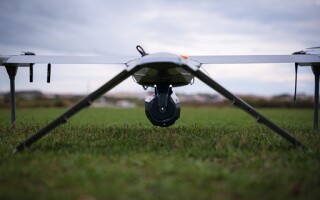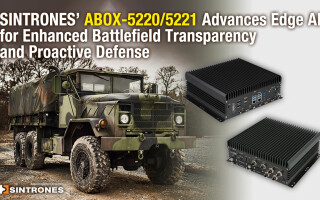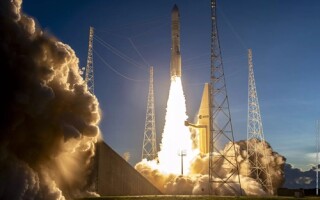Space Fence radar system to identify, track space junk
StoryJanuary 27, 2015
Space Fence, a fully digital S-band radar system, is being built for the U.S. Air Force by Lockheed Martin to better identify and track space junk to help protect military satellites and other space assets by preventing conjunctions and the creation of more debris ? hurtling along at speeds of 17,500 mph - within low-Earth orbit.
Since 1961, the U.S. Air Force has maintained a highly accurate catalog of objects within low-Earth orbit that are larger than the size of a softball, sharing responsibility with NASA for providing situational awareness of this environment to avoid potential conjunctions – a.k.a. “collisions” – with satellites and spacecraft.
Now the Air Force’s Space Surveillance System, which tracks more than 200,000 pieces of debris, will soon be enhanced by “Space Fence,” a fully digital S-band radar system being built by Lockheed Martin, capable of tracking debris as small as 10 centimeters.
Clearly, as space junk continues to proliferate at a rapid pace, it’s critical to be able to know not only where all of this debris is – so that it can be avoided during critical space launches and missions, or to maneuver satellites that cost hundreds of millions of dollars out of harm’s way – but also to be able to identify what exactly it is.
At the heart of the problem is that space junk begets more space junk. In 2007, for example, China’s anti-satellite test, which used a missile to destroy an old weather satellite, contributed 3,000 more pieces of space junk to be tracked. And in 2010, when a defunct Russian satellite collided with and destroyed a functioning U.S. Iridium commercial satellite, it added more than 2,000 pieces of trackable debris (see Figure 1).
Figure 1: Pictured is a radar-generated graphical image of space junk in low-Earth orbit. Image courtesy of NASA.
(Click graphic to zoom)
With every space launch, there is always a risk of creating more space junk via rocket engines and other material jettisoned off, if it is not planned and carried out with foresight. “An astronaut’s glove from a spacewalk, dead satellites, and other equipment that used to be operational are currently among the items in orbit,” explains Steve Bruce, vice president for advanced systems at Lockheed Martin Mission Systems and Training.
Military satellites are not the only space assets that need to be protected from space junk. We rely on a variety of satellites for nearly every aspect – including GPS, banking, and telecommunications – of our interconnected lives now.
Space Fence design
Lockheed Martin’s Space Fence design combines a scalable solid-state S-band radar with a higher wavelength frequency capable of detecting much smaller objects than the Air Force’s Space Surveillance Network.
“Space Fence will become part of the Space Surveillance Network, which is a whole series of radars and optical sensors on the ground and in space charged with discovering where objects are and then tracking them in low-Earth orbit,” Bruce explains. “It will have more capability than any of the systems currently in inventory, provide more sensitivity, and have the ability to track more objects.”
Part of Space Fence’s new capability, for example, involves optical sensors that can be used to identify debris.
What else differentiates Space Fence from earlier radar systems? One key aspect is that its radar is classified as fully digital. “With older radar systems, the antenna was made out of a dish to act as a big deflector, or involved a phased array using electronics at the element level to create an array of transmitters and receivers,” Bruce says. “In the past, those were typically analog radars, in which case an analog circuit formed the combined data from these transmit/receive modules to form beams in space that the antennas could steer.”
Space Fence is also an active electronically scanned array (AESA), but a digital one. Two key pieces make it digital. “First, it uses distributed waveform generators. In the transmit aperture, line replaceable units (LRUs) take digital commands – it creates the transmit waveform right on the digital LRU and sends it through power amplifiers to create a transmit signal,” Bruce continues. “Next, on the receive side, a series of low-noise amplifiers receive the radio frequency energy, which is then digitized to allow us to form numerous simultaneous receive beams. This makes our radar extremely flexible from an energy management perspective.”
The reason Lockheed Martin decided to separate its transmit and receive antennas was primarily to improve the overall efficiency of the antennae. “This allowed us to build a very efficient transmit antenna by using gallium nitride (GaN) technology. It also allowed us to build a larger receive antenna, which needs to be a bit larger to make more accurate measurements about where the objects are in space,” he notes.
In the array, they use a combination of custom technology and specific miniaturized microwave IC. “There are specific electronics in the aperture, but also custom electronics in the aperture. In the back end, our signal processing uses standard server technology,” Bruce says.
“Once we digitize and form digital beams, all the processing uses commercial off-the-shelf (COTS) server technology,” he adds. “So we have a very large server farm that does most of the signal, data, and mission processing. If you look at our compute engines that do orbital mechanics … it really isn’t much different from a typical server farm.” (See Figure 2 on previous page.)
Figure 2: The Space Fence screen shows how operators can track space junk and other debris in orbit.
(Click graphic to zoom by 1.9x)
Another big advantage of Space Fence’s digital radar is that it can be software defined. “This allows us to change the way energy is managed in space, the way waveforms are transmitted or received – it’s all fully programmable. The fact that it can be fully programmed to do many different things in the future adds tremendous flexibility to the system,” Bruce explains. “This is a great asset not only for the U.S., but the entire world.”
Project timeline
As far as a timeline for the Space Fence, the project began in June of 2014, will undergo a critical review in March 2015, and “in less than five years, Lockheed Martin will build the radar, get all of the electronics into it, test it, and then turn it over to the U.S. Air Force for operation by the end of 2018,” Bruce says.
The radar facilities for Space Fence are currently being constructed on Kwajalein Atoll, an island in the Pacific Ocean. In terms of scale, once built, if you looked down on it from above it would look much like a couple of football stadiums.
Once Space Fence is up and running, it will allow the military to determine what types of objects are in low-Earth orbit and to track them. “They’ll use it to manage our U.S. space assets as well as to inform the world about potential conjunctions,” he adds. “It’s in every country’s best interest to know what’s going on so they can maneuver their satellites out of the way to avoid creating more space debris.”
The catalogue of space junk, which currently stands at about 20,000 objects being tracked by the U.S., is expected to grow quite substantially. “No one really knows what’s up there; it could be upward of 200,000 objects that we’ll be able to find and track,” Bruce notes. “But what’s most important is being able to figure out where these objects will be in the future so we can predict and avoid conjunctions.”







